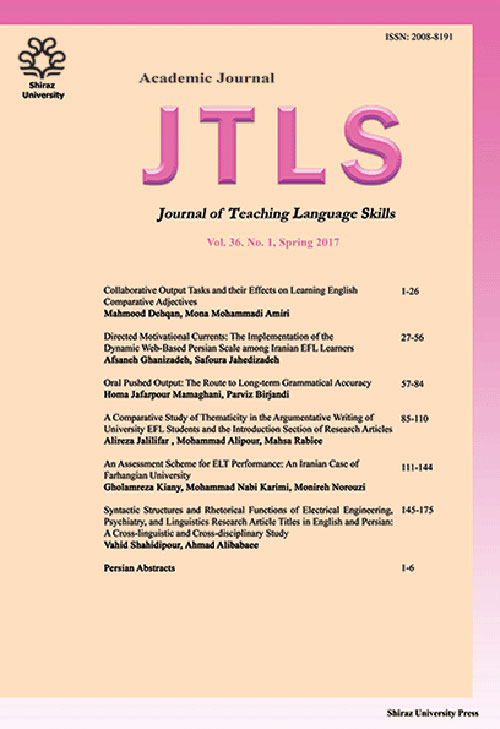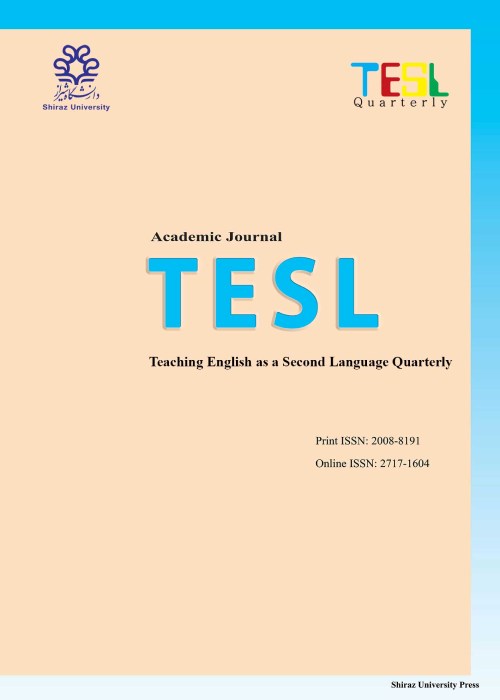فهرست مطالب

Teaching English as a Second Language Quarterly
Volume:10 Issue: 2, Summer 2018
- تاریخ انتشار: 1397/04/10
- تعداد عناوین: 6
-
-
Pages 1-32Although the importance of reading in higher education as an index of success has been highlighted, the metacognitive knowledge or beliefs of graduate students have remained under-researched. This qualitative study reports on a study that, first, examines how graduate students of applied linguistics conceive of academic reading and academic readers in their graduate programs; second, what factors they believe can contribute to the development of those self-conceptions; and, third, if there was the possibility of adding a course on academic reading to their MA programs, how they would judge the advantages and disadvantages of such a course. In so doing, in-depth interviews were conducted with 31 graduate students at eight different universities. The findings revealed considerable changes in the participants' conceptions as the result of taking part in their graduate programs. They attributed those self-conceptions to their efforts and struggles as well as their teachers' help and guidance. Their perceptions of an academic reading course were positive. Pedagogical implications are discussed.Keywords: Metacognitive knowledge, beliefs, academic reading, academic literacy, graduate students
-
Pages 33-64A significant research base has increasingly substantiated that teachers are among the most significant players affecting student achievement in second language classrooms. As a result, teacher-related variables have enjoyed much research attention over the recent decades in both mainstream education and English Language Teaching (ELT). Likewise, the present study was set to test a structural model of collective teacher efficacy, teacher self-efficacy, job satisfaction, and teaching commitment, and specifically to examine the hypothesis that teaching commitment mediates the effects of collective teacher efficacy and teacher self-efficacy on job satisfaction. Using a sample of 312 Iranian EFL teachers, structural equation modeling (SEM) was conducted to establish the structural model. The findings of a confirmatory factor analysis (CFA) confirmed the fitness of both the employed scales and the structural model. The findings and implications of the present study are finally discussed.Keywords: Collective teacher efficacy, teacher self-efficacy, job satisfaction, teaching commitment, EFL teachers
-
Pages 65-90Photovoice is a participatory action research method which aims to enable students to create compelling visual representations and identify the local social issues. This paper attempted to investigate the impact of photovoice as an innovative method on the levels of reflection manifested in EFL learners' narratives. To this end, a convenience sample of 48 Iranian intermediate EFL learners including 17 males and 31 females, learning English in two institutes located in Isfahan, Iran, were chosen. Before research implementation, the participants were provided with comprehensive photovoice guidance and workshop. The learners had to present their photos and narratives during a semester which took about two months. The collected data include 237 photographs and 48 essays which were learners' critical reflection on the photos. Then, the levels of reflection in their narratives were measured by Kember (2008) and Ryan and Ryan's (2012) frameworks. According to the results, poverty and air pollution were the most prominent social concerns captured by the participants. Furthermore, photovoice incredibly fostered Iranian EFL learners' reflection, and they all had positive attitudes toward participatory learning. This study could have pedagogical implications for the learners and practitioners in the field of SLA. They can employ innovative methods such as photovoice as a participatory learning tool to improve critical reflection.Keywords: Learners', narrative, Participatory learning, Photovoice, Reflective narrative
-
Pages 91-123Second language (L2) theories have for long acknowledged the importance of focus on formulaicity or conventionalized lexical chunks. Yet, there has been little attempt to examine the impact of this on foreign language learners’ development of complexity, accuracy, and fluency (CAF) measures. The purpose of this study was twofold: First, to see whether lexis-based instruction had any significant effects on EFL learners' oral CAF, and, second, whether different types of lexis-based instructions (e.g., using corpus-based concordances, textual lexis enhancement, and audio-visual captioned lexis) had differential effects. Participants were 54 EFL undergraduates at an Iranian university. After checking the initial homogeneity, 2 groups of participants were randomly assigned to experimental (lexis) and control (non-lexis) groups. After pretesting on CAF, the lexis sub-groups received the 3 types of lexis-based instructions in a counterbalanced manner. After each lexis instruction, students’ oral data were also obtained. The control group received mainstream non-lexis instruction. One-way MANCOVA results pointed to the significant effects of lexis instruction on oral CAF measures. Specifically, repeated-measures MANOVA results revealed that audio-visual captioned lexis was the most effective modality in heightening formulaicity. The findings suggest that focus on lexis is beneficial to L2 learners’ oral skills. Further theoretical and pedagogical implications are discussed.Keywords: Lexical chunks, lexis-based instruction, CAF measures, corpus-based concordances, textual lexis enhancement, audio-visual captioned lexis
-
Pages 125-167Considering the challenges inherent in learning and teaching of summary writing in EFL/ ESL settings, it is crucial to look into various instructional techniques thoroughly. This study investigated the relative effectiveness of three summary writing techniques: Sequence map, answering question, and 3-2-1 technique. To this end, 60 language learners from an English language institute in Ahvaz participated in the study. Before implementing the instructional techniques, a pre-test was administered to gauge the participants' fundamental knowledge of L2 summary writing. Three experimental groups were instructed through the already-mentioned techniques for ten weeks while the control group was given no such treatment. Finally, a post-test was administered to ascertain the effectiveness of such techniques in improving EFL learners' summary writing. The TOEFL-iBT scoring rubric was adopted to score the summaries holistically. Paired sample t-test and ANOVA were run to analyze the data. The findings revealed that the sequence map group outperformed the other three groups in terms of the written summaries. The study further implies that the employment of graphical or spatial representation of textual concepts reduces the complexity and ambiguity of the presented information.Keywords: Summary writing, sequence map, answering question, 3-2-1 technique
-
Pages 169-193By the end of the 2020s, a change involving the substitution of the Communicative Approach to English teaching for the Structural one has been fully operative in the Iranian secondary education system. This study set out to explore the views of Iranian teachers vis-a-vis the changes introduced into the education policy of the nation since teachers as end-point policy workers play a pivotal role in the ultimate success or failure of any curricular activity. Using data from semi-structured interviews and follow-up procedures, the investigation sought to delve into how eighteen EFL teachers at the upper secondary education level made sense of changes effected at the intersection of policy and practice. Common patterns and themes were identified and presented at the level of data analysis. Despite embracing the changes, the results showed that the teachers sensed that they had been left to their own devices in translating policy into practice and that the proposed reforms were not all-inclusive in the sense that significant stakeholders including parents, school counselors, and educational leaders had been left out. They were further keenly aware of a number of obstacles in the way of policy enactment and found especially the prevalence of a regime of cramming for tests leading to the dominance of a negative teach-to-the-test culture, limited support available and infrastructural challenges, as well as resistance to change among structurally-minded practitioners as highly detrimental to implementation of change. Implications for policy, practice, and research are finally given.Keywords: EFL, language education policy, Iran, curricular innovation


